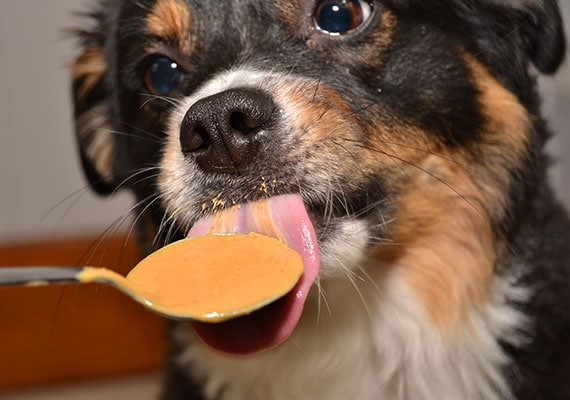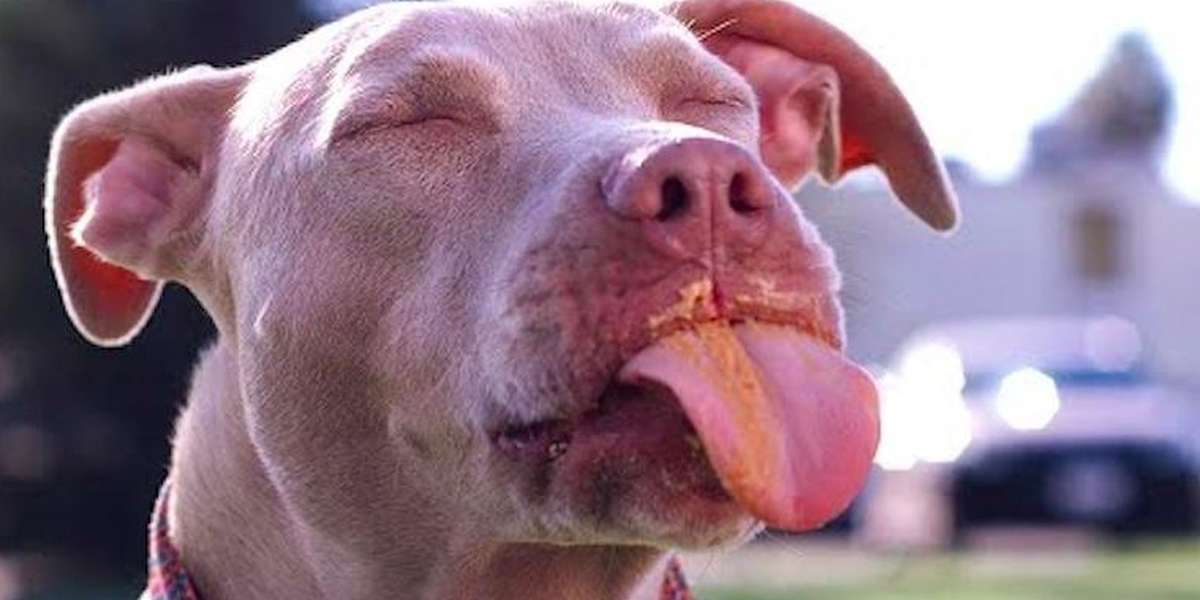Last Updated on February 12, 2024 by Fumipets
Unraveling the Nutty Truth – What Kind of Peanut Butter is Safe for Dogs?
Peanut butter is a canine favorite, a delightful treat that often leaves our furry friends drooling with anticipation. However, not all peanut butter is created equal, and concerns about certain ingredients have prompted pet owners to question which types are safe for their dogs.
In this guide, we delve into the nutty details, exploring the safety of various peanut butter options to ensure your canine companion enjoys this tasty indulgence without any risks.
What Kind of Peanut Butter is Safe for Dogs?
Peanut butter is generally good for dogs, and most of them like it! Peanut butter makes an excellent “high value” reward, may be used to conceal medicines, and can even be used to distract your dog when bathing or clipping their nails.
While most kinds of peanut butter are suitable for dogs, not all peanut butters are, and not all quantities are, as well.
This kind of peanut butter should not be given to your dog.
It’s difficult to tell if giving your dog even a modest quantity of peanut butter is safe. And there’s only one word to explain why: xylitol!
Xylitol is a sugar-replacement sweetener that may be found in a variety of goods, including certain peanut butter brands. It’s an “all-natural” sugar replacement that’s safe for humans, but it’s incredibly toxic to dogs, killing thousands of them every year. Preventive Vet is pleased to announce that there has been a rise in public awareness of xylitol – both in peanut butter and in the more than 700 other items containing xylitol – and that we have been able to persuade several firms to adjust their labelling and warning policies. (Skip to the bottom of this article to see how far we’ve come.)

Why Is Xylitol Harmful to Dogs?
Xylitol is a sugar alternative that’s becoming more popular due to its dental advantages and appropriateness as a sugar substitute for diabetics. Thousands of dogs are poisoned by xylitol inadvertently every year.
In fact, xylitol has a lethal dosage in dogs that is even lower than chocolate! In a 30-pound dog*, for example, 1.37 grams of xylitol may produce a fast decrease in blood sugar (“hypoglycemia”), resulting in stumbling, confusion, collapse, and seizures. If a dog of the same size ate 6.8 grams, the liver cells would be destroyed, which would be debilitating and maybe fatal. Consider that the same degree of acute poisoning would need 22 times the amount of dark chocolate (150 grams).
Peanut Butter Brands That Aren’t Safe for Dogs Because They Contain Xylitol
There are still four known xylitol-containing peanut/nut butter brands (down from five), and others may appear, so check labels carefully.
Keep these xylitol-containing products away from your dog when choosing a peanut butter or peanut-flavored spread:
- Go Nuts, Co.
- Krush Nutrition (appears to no longer be in production)
- Nuts ‘N More
- P28
The rising popularity of xylitol as an ingredient in a growing number of products — including gums, mints, chewable vitamins, ice creams, common supplements, and more — emphasizes the importance of reading ingredient labels, as well as the dangers of assuming that what’s safe for you or your kids is also safe for your pets. Check out our list of over 700 xylitol-containing goods; many may surprise you!
/cloudfront-us-east-1.images.arcpublishing.com/gray/K63SFF4VTFO2JPPUSHUJ7MUR3Q.bmp)
What Is the Best Peanut Butter for Dogs?
In general, any peanut butter that does not include xylitol (or chocolate) is safe for dogs. It may provide your dog with a solid supply of protein and healthy fat if consumed in moderation. Some peanut butters, on the other hand, are healthier than others.
When it comes to your dog, a lot of peanut butter on the market has wonderful features, but it’s likely to have preservatives and additional sugar that aren’t so great. Finding peanut butter (or other nut butter) that is low in or totally devoid of additives is your best chance. Crazy Richard’s peanut butter (or CB’s Nuts peanut butter) has just one ingredient: peanuts. Look for a peanut grinder in the natural foods area of your grocery store so you can make one-ingredient peanut butter at home.
Also, don’t think that just because something says “all-natural” or “no artificial sweeteners” on the front label that it’s safe for your dog. Technically, xylitol is an “all-natural” sweetener!
You can simply create your own peanut and nut butter at home if you have a good blender or food processor. Your dog will be healthier as a result, and you won’t be able to tell the difference.
How Much Peanut Butter is OK for Dogs?
A little amount of xylitol-free peanut butter for your dog will probably be safe; but, if you overdo it, you risk giving your dog pancreatitis (which is unpleasant and costly) and/or contributing to obesity.
As a result, you should be cautious about how much peanut butter — or any other treat — you feed your dog. Treats should account for no more than 10% of your dog’s daily calories, according to the rule of thumb.
The quantity of peanut butter used will vary from dog to dog and peanut butter to peanut butter (check the caloric count on the label). Small dogs should have no more than 1/2 tablespoon of peanut butter per day, while bigger dogs should consume no more than 1 tablespoon. “Is Peanut Butter Good for Dogs?” has a more extensive analysis.
PRO TIP: Even a tiny quantity of a high-fat treat like peanut butter may trigger or aggravate pancreatitis in dogs with chronic pancreatitis or those at greater risk for developing acute or chronic pancreatitis, such as Miniature Schnauzers and Yorkshire Terriers.

Peanut Butter for Dogs: Creamy or Crunchy?
It’s possible you’ve heard that gritty peanut butter might cause choking in dogs. Unless you give a very little dog a very huge quantity of crunchy peanut butter, this is quite improbable.
However, as you learned in the last section, even a medium-sized dog should only be given approximately a tablespoon of peanut butter every day, so you’re unlikely to offer enough at once to pose a choking threat.
So go ahead and feed your dog whatever peanut butter you have on hand, whether it’s creamy, crunchy, extra crunchy, or any other variant. If you want to distract your dog during a bath (smear peanut butter on the bathtub or shower wall to distract your dog) or while trimming their nails (smear peanut butter on a plate so your dog will be so busy licking that they won’t notice or care that you’re cutting their nails), creamy peanut butter is easier to smear.
Is it OK for Dogs to Eat Peanut Butter and Jelly?
It’s one thing to give your dog peanut butter, but jelly should be avoided. Why? To begin with, jam, jelly, and preserves contain a lot of sugar; if you already feed your dog peanut butter, adding more sugar can raise your dog’s risk of obesity and diabetes. Second, some jelly includes xylitol, which is toxic to dogs. Third, certain varieties of jelly include fruits that should not be fed to your dog.
Strawberry jelly, for example, is not poisonous to dogs, but grape jelly is. Some dogs get poisoned by grapes, which may result in severe renal failure. Raisins and currants are the same way.
When it comes to pampering your dog, it’s better to keep the jelly and jam to a minimum.
Is it possible for dogs to be allergic to peanuts?
In contrast to some people, dogs do not seem to be allergic to peanuts. I’m not aware of any reported incidences of allergic or anaphylactic responses in dogs to peanuts, or any other nuts or seeds. However, this does not eliminate the possibility.
If you’re worried about your dog’s first (or second) experience with peanut butter or another nut butter, give them a modest quantity to begin with (like a lick off the tip of your finger) and keep a watch on them. Below are some warning signals to look out for. You should be OK as long as none of these symptoms appears within an hour.

Symptoms of a severe acute allergic response in dogs:
- Hives or tiny swollen regions on their bodies
- Swelling of the eyes and/or the muzzle
- Breathing problems or rapid breathing
- Vomiting
- Diarrhea
- Collapse
- Unbearable itching
Symptoms of a mild to severe chronic food allergy in dogs:
- Ear infections that be chronic or recurring
- Fur coat with a thin sheen
- Itching and/or biting of their paws on a regular basis
- Anal glands that are influenced on a regular basis
Questions & Answers on Safe Peanut Butter for Dogs:
Is All Peanut Butter Safe for Dogs?
Not all peanut butter brands are created equal when it comes to canine safety. While plain, unsalted peanut butter is generally safe, varieties with additives like xylitol, a sugar substitute, should be avoided at all costs.
Why is Xylitol Dangerous for Dogs?
Xylitol is highly toxic to dogs and can lead to a rapid release of insulin, causing hypoglycemia (low blood sugar). This sweetener can be found in some peanut butter brands, so always check the label before sharing a spoonful with your furry friend.
What Ingredients Should I Look for in Safe Peanut Butter?
Opt for peanut butter with minimal ingredients – ideally, just peanuts and maybe a touch of salt. Avoid additives like sugar, salt, and hydrogenated oils, as these can be harmful to your dog’s health.
Are Homemade Peanut Butters Safer for Dogs?
Homemade peanut butter can be a great option, allowing you to control the ingredients. Simply blend unsalted peanuts until creamy. However, always check with your vet to ensure it meets your dog’s dietary needs.
How Much Peanut Butter is Safe for Dogs?
Peanut butter is calorie-dense, so moderation is key. A small spoonful or using it as a treat during training is generally safe. However, consider your dog’s size and dietary requirements, and avoid excessive consumption to prevent potential health issues.


















